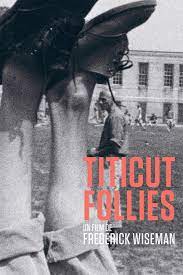
“Titicut Follies” was released in 1967 and was written, produced and directed by Frederick Wiseman. It is an American documentary. In 1966, Wiseman was given permission to film inmates and daily activity occurring in the Bridgewater Massachusetts State Hospital for the Criminally Insane. The filming took about a month, the editing about a year. In 2022, the film was selected for preservation in the United States National Film Registry by the Library of Congress as being "culturally, historically, or aesthetically significant". The title of the film is taken from a talent show put on by the patients and hospital staff. The word Titicut is the Wampanoag tribe name for the nearby Taunton River.
It is a very controversial, embarrassing and depressing film. The images are raw and graphic. People are either being herded like cattle or ignored. The film shows the stark conditions of the institution. Men spend most of their time naked locked into rooms with nothing except a thin mattress on the floor. They are given medication to the point of being almost catatonic. Rehabilitation doesn’t exist and the staff treats the inmates apathetically if not cruelly. The patients are given little respect or humanity. By 1987, seven of the inmates had died. The hospital was sued by the family of one of the victims.
The state of Massachusetts tried to prevent the film from being released. They stated that the inmates’ “right to privacy” was being invaded. Wiseman noted that he had permission to do the film and that the state was infringing on his freedom of speech. He also believed that the state was more concerned about the institution looking bad than they were about human rights. It is noted as the only film banned for reasons that had nothing to do with obscenity, violence or national security. The court wanted all copies of the film destroyed. Wiseman appealed the decision. For a while the film was only released for educational purposes. Eventually the film was released to the general public in 1991. The court decided that by then most of the inmates involved had died so there was no longer the issue of “right to privacy”. Although the film is more documentary than propaganda, the suppression of the film could, by itself, be considered a propaganda move.
Built in 1855, the institute was at first a poorhouse, it then became a workhouse. Eventually it was turned into a hospital for the criminally insane. Over the years several of the staff was killed by inmates trying to escape. At one point, Albert DeSalvo (the Boston Strangler), was housed there.
The film uses what is known as “direct cinema”. It is a way of filmmaking used mostly in documentaries. Developed in the late fifties and early sixties, the method uses film as an observation tool. Events and people are filmed with no interaction with the cameraman or the director. Hand held cameras are usually used to capture candid images and interactions between those being filmed without a lot of distraction on the part of the filmmakers. It is the precursor to people filming random events with their phones.
In 1968 a study on the institution found that the courts committed 30 people illegally. Many inmates were incarcerated long after their sentences had expired. One man sentenced to two years in 1910 was still at the hospital in 1967. Another patient sentenced to two years was incarcerated for 28 years. Not all of the inmates sent there were for violent crimes.
The hospital is still in existence.
There is some male frontal nudity in the film.

